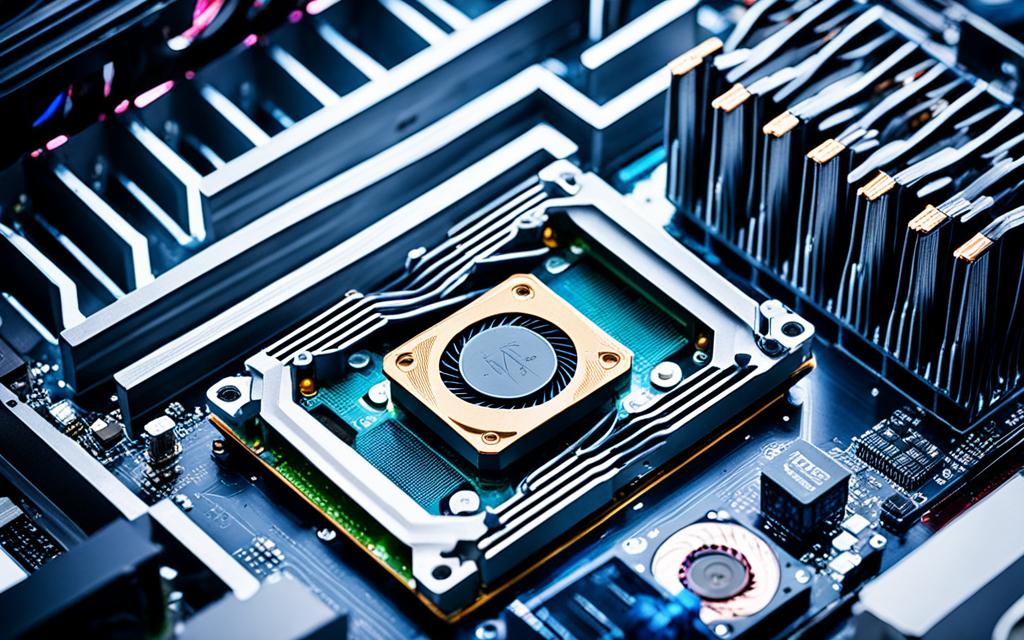Table of Contents
Today, knowing how to handle high CPU temperatures is key to your computer’s health and speed. Overheating of the CPU can lead to problems when it’s loaded with many tasks or when the cooling system isn’t up to par. You might notice your computer’s fans getting louder and it feeling hotter.
Many things cause high CPU temperatures, like too much dust, poor airflow, or broken parts. Ignoring the issue can result in serious damage to your computer. It’s crucial to keep an eye on the CPU’s temperature. Keeping it below 60°C (140°F) is best to avoid harm. For those who love gaming or run heavy programs, staying between 70° to 85°C (158°F to 185°F)1 is okay.
If temperatures go above 90°C (194°F), the danger of permanent damage increases1. So, it’s very important to manage your CPU’s temperature well to ensure your device lasts a long time.
Key Takeaways
- Monitoring CPU temperature is essential to prevent overheating.
- Ideal CPU temperature should remain below 60°C to avoid damage.
- Normal workload temperatures range between 40–65°C, spiking higher during intensive tasks.
- Dust build-up and poor ventilation significantly contribute to high CPU temps.
- Regular checks and cleaning can prevent performance issues caused by overheating.
- Using third-party applications can help determine and manage CPU heat levels effectively.
Understanding CPU Temperatures
Keeping an eye on CPU temperatures is key for good computer performance. When the CPU gets too hot, it works less effectively and parts can wear out faster. This can also lead to higher chances of computer problems. If the temperature climbs too high, the CPU may slow down to avoid damage.
What Happens When CPU Temperatures Rise?
If a CPU gets too hot, like over 80 degrees Celsius from heavy use, it will start to slow down. This slowing down is to keep the CPU from getting damaged when it’s over 95 degrees Celsius2. While a CPU can work well between 40-60 degrees Celsius, going over 100 degrees can be harmful3.
How CPU Works and Generates Heat
CPUs get hot mainly due to the intense electrical activity when the computer is working hard. For example, when doing tasks that demand a lot, the temperature shoots up. AMD and Intel CPUs can handle up to 95 and 100 degrees Celsius, respectively2. It’s vital to have methods to manage the heat and to check the temperatures regularly2.
What is a High CPU Temp?
Knowing when your CPU is too hot is key to keeping your computer running well. A CPU temperature above 85°C (185°F) during normal use is too high. Usually, CPUs work best between 40–65°C (104–149°F) under typical workloads. For tougher tasks, temperatures can reach 70–80°C (158–176°F)4 and5. If it goes over 90°C (194°F), the damage might be permanent, harming your computer’s health.
Safe Operating Temperatures for Various CPUs
Different CPUs have different safe temperatures. For instance, Intel’s Core i5-9501 should stay under 70 to 80°C to prevent harm6. AMD’s Ryzen 5 3600X has a max temperature of 95°C but should be below 65 to 75°C for the best performance6. Ideal idle temperatures are usually between 30 to 40°C (86 to 104°F)5. Under workload, 60°C to 70°C (140°F to 158°F) is expected5. But, risks increase greatly if the temperature is often above 80°C (176°F)5 and6.
Symptoms of High CPU Temperatures
Knowing the signs of a too-hot CPU can help you fix issues early. Signs to watch for include:
- Sudden system crashes or instability
- Increased and excessive fan noise
- Heat coming from the hardware
- Sluggish response times or performance lags
Dust in your PC case can also lead to overheating4. Keeping an eye on CPU temperatures with BIOS or other apps can alert you to heating problems5. Acting quickly on these signs helps keep your CPU’s temperature in a safe range and avoids further trouble.
How to Check CPU Temperature
Knowing how to check your CPU temperature is vital to keep your computer running well. It’s important because it affects your computer’s performance and its lifespan. By learning different ways to check, you can make sure your CPU stays within the safe temperature range. This helps avoid overheating and the problems it brings.
Using Third-Party Applications
One effective method is using third-party apps. Programs like HWMonitor, Core Temp, and NZXT CAM give you live updates. They show how hot your CPU is and how well it’s doing. You can see the highest temperatures your CPU has reached. This gives a clear picture of its heat levels.
Keeping an eye on these numbers is key. It tells you if the temperature goes above the normal 40–65°C during everyday tasks. Or if it jumps to 65–80°C during heavy use like gaming or video editing7. Take a look at why it’s important to monitor CPU for a smooth-running system.
Manually Checking through BIOS/UEFI
Another way to check is through the BIOS/UEFI settings. You can do this by restarting your computer and going into the BIOS/UEFI. There, the motherboard shows the CPU temperature. This simple check makes sure your CPU is not too hot.
Keeping CPU temperatures in the safe zone of 45-100°C is crucial. Going over 100°C can cause shutdowns and even permanent damage8. Good air flow and keeping your system clean are great ways to prevent overheating9.
Common Causes of High CPU Temperatures
Knowing why your CPU gets too hot is key to keeping your computer running well. Many things can make your CPU’s temperature rise. It’s very important to be aware of these causes.
Overclocking and its Effects
Overclocking makes a big difference in CPU heat. It forces the processor to work harder than it’s meant to. About 15% of overheating comes from overclocking10. This makes the CPU put out more heat.
If you don’t manage this heat, your computer might not work as well. It could even become unstable. So, it’s good to use tools that help you keep an eye on the heat. This way, you can avoid harming your computer.
The Impact of Dust and Poor Ventilation
Dust can block the air inside your computer, which makes it hotter. Heatsinks covered in dust get too warm11. Also, about 18% of heat issues come from not having enough air flow in the case10.
Clean your computer often to stop dust from gathering. Making sure your computer’s surroundings are tidy helps keep the air moving well. This is crucial for keeping things cool and running smoothly.
Keeping your computer well-maintained lowers the risk of overheating. For instance, updating your BIOS and drivers helps a lot. So does keeping your computer clean. These steps can really make your system cooler when you turn it on11.
Explore more about maintaining optimal system.
Conclusion
Keeping your CPU’s temperature safe is key to making your computer work well and last long. It’s important to regularly check and take steps like using the right cooling methods. For example, some start with CPU temperatures between 50-60ºC when idle. But, cleaning regularly and applying fresh thermal paste can drop this by 10-15 degrees12.
It’s vital to know how heat builds up with different tasks, since Intel CPUs start slowing down at 100 ºC13. Using high-quality coolers like the Cooler Master Hyper TX3 helps keep it cooler and boosts performance13. After these changes, idle temperatures can fall to 35-50 degrees, with stress tests only raising them above 70 degrees12.
Improving cleanliness, the setting, and cooling methods can greatly enhance your computing. Investigate various options, such as switching to a lighter Linux version, for a better system. These actions not only keep your CPU cool but also tackle overheating, ensuring your computer runs well for years.
FAQ
What can I do if my CPU is overheating?
Act quickly by ensuring good airflow, clearing dust, and verifying cooling systems. Use a CPU monitoring tool to keep an eye on temperatures.
What are the signs that indicate high CPU temperatures?
High CPU temperatures cause sudden crashes, loud fan sounds, hardware warmth, and slow performance.
How can I maintain safe CPU operating temperatures?
Keep it cool by cleaning vents, using efficient coolers, and monitoring temperatures with apps like Core Temp or HWMonitor. These steps are key.
What temperature is considered too high for a CPU?
Temperatures above 85°C (185°F) are too high. Over 90°C (194°F) can damage the CPU permanently.
Is overclocking my CPU worth the risk of potential overheating?
Overclocking boosts performance but risks overheating. It’s important to have strong cooling. Think about how it affects your CPU over time.
What should I do if my CPU fan is making excessive noise?
Noise from a fan suggests overheating. Clean the fan and Improve airflow. You might need a better cooling system.
Can inadequate ventilation lead to CPU overheating?
Definitely. Poor ventilation reduces cooling. Make sure your PC is in a spacious place, away from anything blocking air.
How often should I check my CPU temperature?
Regular checks are wise, especially after updates or when using intense software. It helps you spot overheating early.
Source Links
- https://www.pandasecurity.com/en/mediacenter/how-to-check-cpu-temp/ – How to Check Your CPU Temperature – Panda Security
- https://www.tomshardware.com/how-to/how-to-check-cpu-temp-temperature – How to Check Your CPU Temperature
- https://community.spiceworks.com/t/what-is-a-normal-temperature-for-a-cpu-and-how-do-i-keep-it-low/948818 – What is a normal temperature for a CPU and how do I keep it low?
- https://www.linkedin.com/advice/1/how-can-you-lower-your-cpu-temperature-too-high – How can you lower your CPU temperature if it is too high or overheating?
- https://www.noyafa.com/blogs/knowledge-base/good-cpu-temperature – What Is A Good CPU Temperature? A Guide to Keep Your Processor Cool
- https://www.maketecheasier.com/troubleshoot-high-cpu-temperature/ – How to Cool Down a High CPU Temperature
- https://www.avg.com/en/signal/check-cpu-temperature – How to Check and Monitor CPU Temperature on Windows and Mac
- https://softwarekeep.com/blogs/how-to/how-to-check-cpu-temp-in-windows-10-11 – How To Check Your CPU Temperature in Windows 10/11
- https://koolingmonster.com/insights/how-to-check-cpu-temperature-and-why-is-it-important – How to Check CPU Temperature and Why Is It Important? — Kooling Monster
- https://www.linkedin.com/advice/0/what-common-causes-symptoms-cpu-overheating-skills-computer-repair – What are the common causes and symptoms of CPU overheating?
- https://softwareg.com.au/blogs/computer-hardware/cpu-temp-high-on-startup – Cpu Temp High On Startup
- https://forums.linuxmint.com/viewtopic.php?t=357671 – [SOLVED] High to critical CPU temp, despite low usage
- https://www.pugetsystems.com/labs/articles/impact-of-temperature-on-intel-cpu-performance-606/ – Impact of Temperature on Intel CPU Performance








